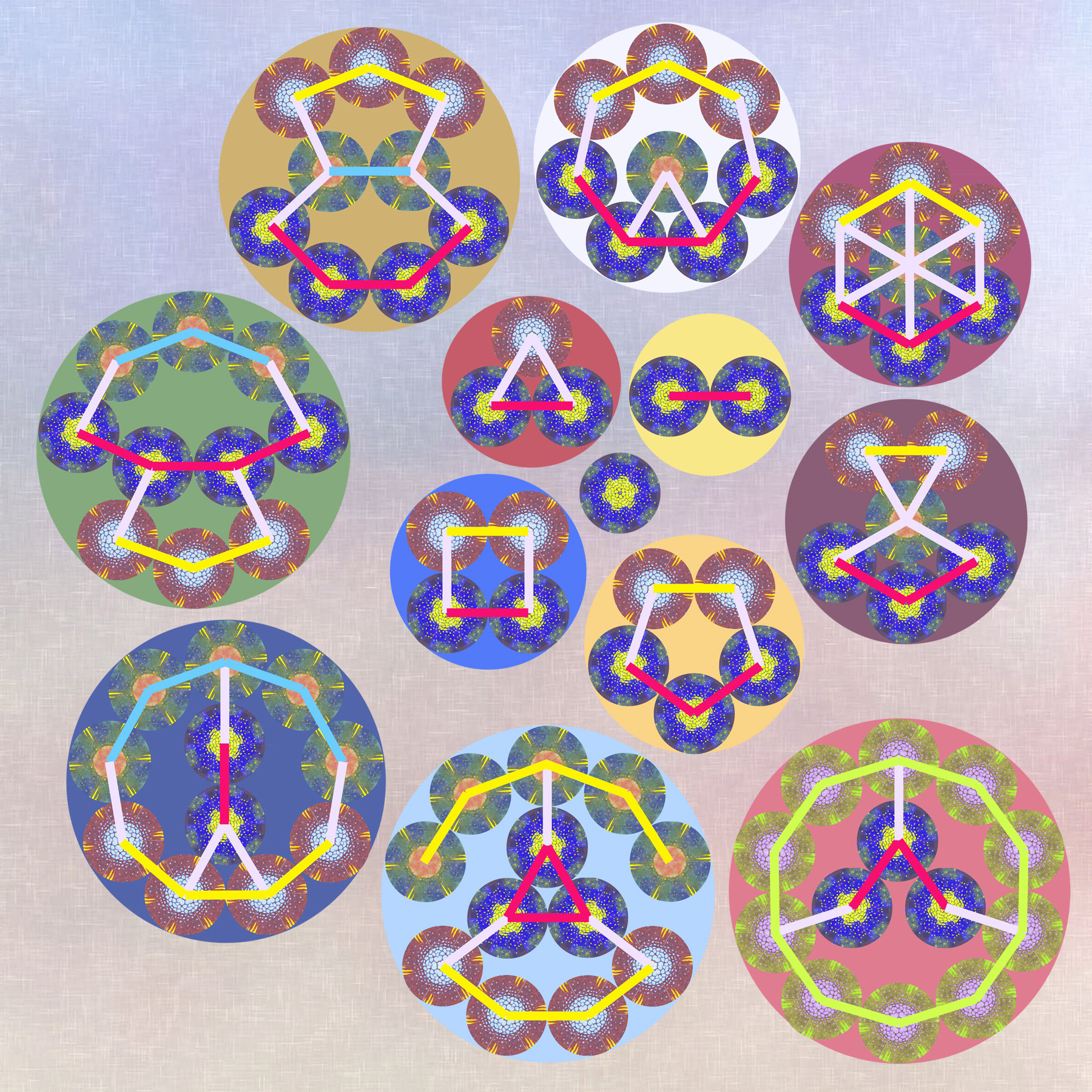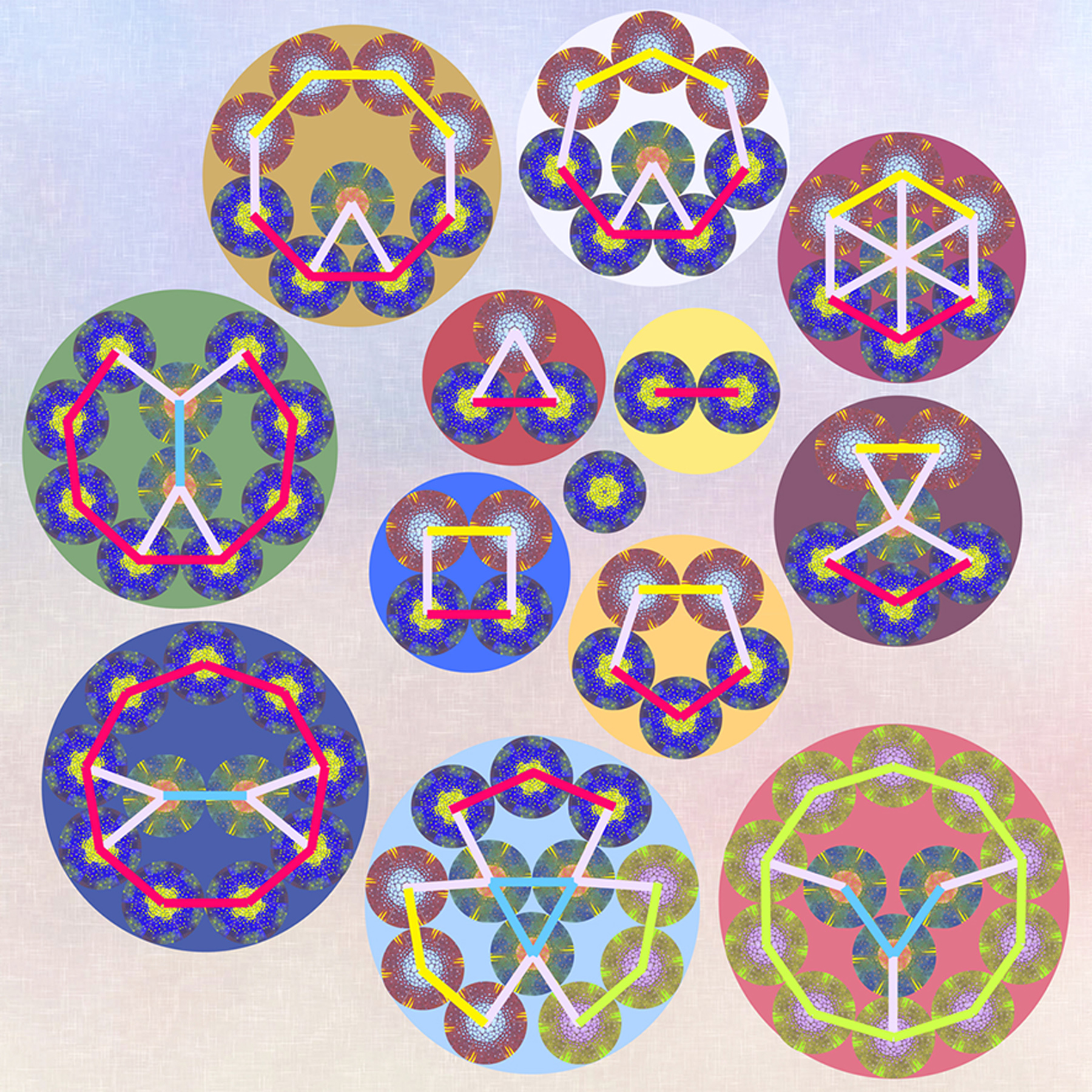
Mathematics illustration
Circle-inscribed integers
Unity is represented by the unit circle. Each successive integer must then be packed into the smallest possible circle. I attempted this using judgement and trial and error – one of the purposes of this experiment was to explore how much can be achieved by empiricism. This also enabled me to approach the task without preconceptions.
My criteria were as follows. All the units for each integer must be connected by a graph. Strings of ‘beads’ are preferable to clusters, mimicking natural processes such as organic molecule formation or the growth of single-cell organisms. The bonds linking strings of ‘beads’ (shown in contrasting colours) are taken to be stronger than those connecting separate strings (shown in pale lilac); hence strings can slide past and around each other to create new formations. Each configuration must have a vertical line of ‘head-to-tail’ symmetry (mimicking most animals). Preference is given to ‘energetically balanced’ configurations – ones with gaps that do not dramatically differ in size. The outer units of each configuration should touch the circumference of the enclosing circle.
My methodology was to take the previous configuration, add an extra unit and rearrange according to the criteria. The protrusion of units beyond the old circumference was kept as equal and as small as possible before a new circle was then drawn. Where it was necessary to break a bead chain, the colours of the reconfigured units were altered; where two colours were available I made an aesthetic choice. The integers are aesthetically arranged in an anticlockwise spiral starting with 1 at the centre right of the image, and the background colours of the circles are the hues that I synaesthetically associate with the integers 1-13.
Since there is no ban on open strings of beads, number 12 contains a bead loop with external angles of 37.5. This would require 48 repetitions to join up with itself again, creating a detailed star or ring: 37.5 × 48 = 1800 and 1800 – (360 × 5) = 0. However, this configuration did not turn out to be optimal when I compared my radii with those that have been mathematically proven.

When the experiment was complete I compared my diagrams with the mathematically proven configurations (second artwork).[1] My circles 1–8 and 13 were correctly configured, with radii correct to 1 decimal place, 4 and 5 being correct to 2 decimal places. My 9, 10, 11 and 12 had non-optimal configurations, the 9 configuration accounted for by my criterion of avoiding unbalanced gaps, while 10 was clearly an evolution from 9. Although my 11 configuration was slightly non-optimal, its circle was correct to 3 decimal places: 3.923. The correct configuration for 12, my favourite number, is much more aesthetically pleasing than mine but had eluded me, perhaps because I was thinking in terms of head-to-tail symmetry; indeed, colouring it to distinguish the three peripheral groups of 3, each 120 apart (as I could not resist doing) breaks the rule about a vertical line of symmetry.
The unit beads all have a faint hexagonal grid in their design, as a reminder that this is the most efficient way of packing circular units. The hexagonal formation means that the enclosing circles for 6 and 7 are exactly the same size: 7 units fit in a fully connected formation, and when there are only 6 units the 5 outer ones must still accommodate a central unit. An interesting question is whether there are other larger pairs of integers where this is also the case; I have not researched whether that has been proven.
All the results for integers 1–13 have been proven. However, the optimal conjectured configuration for 14 (by Goldberg), has not yet been proven. I deliberately avoided looking at his arrangement, so that it will be an interesting next step to try 14 intuitively also and see whether my conjecture is the same as Goldberg’s.
[1] https://en.wikipedia.org/wiki/Circle_packing_in_a_circle
